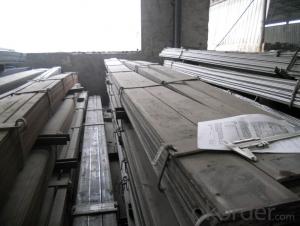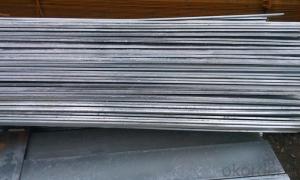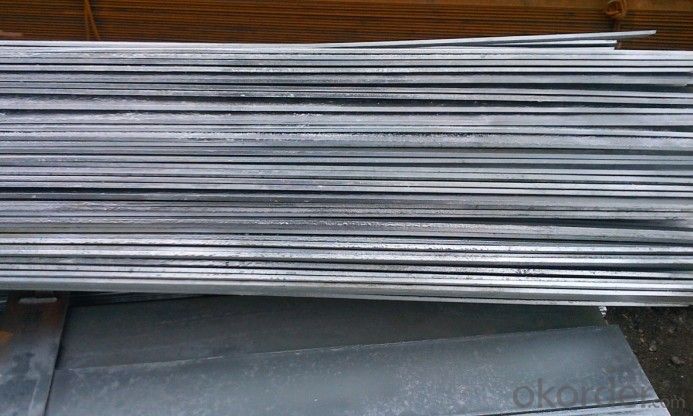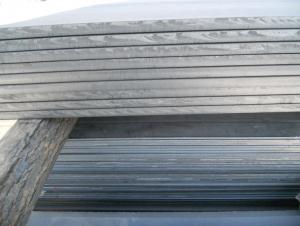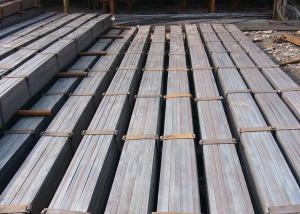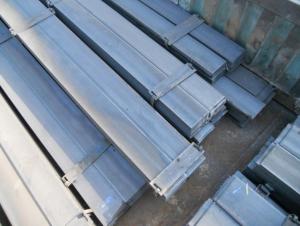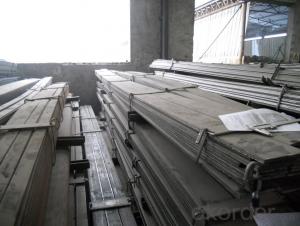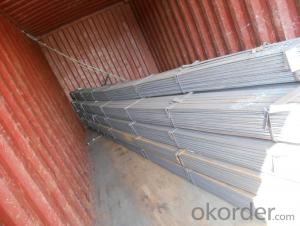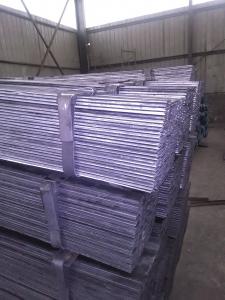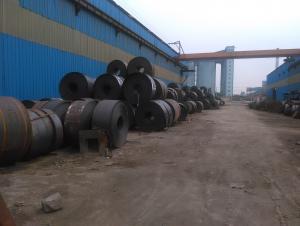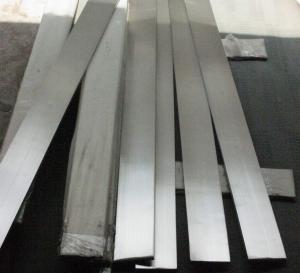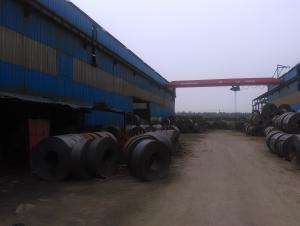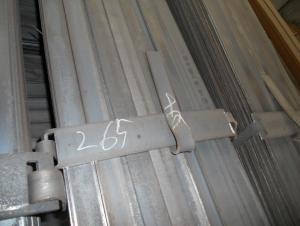flat bar
- Loading Port:
- China Main Port
- Payment Terms:
- TT OR LC
- Min Order Qty:
- -
- Supply Capability:
- -
OKorder Service Pledge
OKorder Financial Service
You Might Also Like
Product Description:
Specification of Mild Steel Flat Bar
Commodity: Mild Steel Flat Bar
Standard: GB;JIS
Material: Q195-235;SS400
Brand name: FLATSPACE
Origin place: China
Thickness: 3mm-30mm
Width:20mm-200mm
Length: Max 12m
Certification: SGS/BV
Chemical composition of Q235
Alloy No | Grade | Element(%) | ||||
C
| Mn
| S
| P
| Si
| ||
Q235
|
B
|
0.12—0.20 |
0.3—0.7 |
≤0.045 |
≤0.045
|
≤0.3
|
Physical properties of Q235
Alloy No | Grade | Yielding strength point(Mpa) | Tensile strength (Mpa) | Elongation after fracture(%) | ||||||
Thickness (mm) | Thickness (mm) | |||||||||
≤16 | >16--40 | >40--60 | >60--100 |
| ≤16 | >16--40 | >40--60 | >60--100 | ||
≥ | ≥ | |||||||||
Q235 |
B |
235 |
225 |
215 |
205 |
375--500 |
26 |
25 |
24 |
23 |
Usage/Applications of Mild Steel Flat Bar
Widely used for construction, Machinery manufacturing, Iron tower steel structure, Shipbuilding; Steel grating, Staircase, Bridge, Viaduct, Railway spare parts, Boilers making etc.
Packaging & Delivery of Mild Steel Flat Bar
Packaging Details: The Mild Steel Flat Bars are packed in bundles and loaded in 20 feet/40 feet container, or shipped by bulk cargo ,also we can do as customer's requirements.
Delivery Details:30~45 days upon the receipt of buyer payment by T.T. or L/C.
Production Flow of Mild Steel Flat Bar
The Mild steel flat bar is made through three processes:
1.Feeding the material: Feeding the row material (the steel plate) to Slitting Line.
2.Slitting:The steel plate would be slitted into expected width by lengthways cutter.
3. Leveled and cutting: The plat bar would be ground into level by the grinder and then cut into required length
- Q: Can steel flat bars be used for making brackets or supports for lighting fixtures?
- Yes, steel flat bars can definitely be used for making brackets or supports for lighting fixtures. Steel is a strong and durable material that can provide the necessary support and stability required for holding up lighting fixtures. Additionally, steel is resistant to corrosion and can withstand heavy loads, making it a reliable choice for such applications. The flat shape of steel bars allows for easy fabrication and customization to meet specific design requirements. Moreover, steel can be easily welded, drilled, or bent to create brackets or supports that can securely hold lighting fixtures in place. Overall, steel flat bars are a suitable and commonly used material for making brackets or supports for lighting fixtures.
- Q: Can steel flat bars be drilled or tapped easily?
- Drilling or tapping steel flat bars is a breeze. Steel is a versatile material that can be machined using a variety of tools and techniques. To drill holes in steel flat bars, you can use either a drill press or a handheld drill with the appropriate drill bit. Likewise, creating threads in steel flat bars is achievable with a tap and die set. However, the ease of drilling or tapping may vary depending on the thickness and hardness of the steel. Thicker and harder steel bars may require more power and specialized tools for drilling or tapping. Moreover, employing cutting fluids or lubricants can enhance the ease and efficiency of the drilling or tapping process.
- Q: Are steel flat bars available in different grades and alloys?
- Yes, steel flat bars are available in different grades and alloys. Steel is a versatile material that can be modified to suit specific applications by varying its composition. Different grades and alloys of steel have different properties, such as strength, corrosion resistance, and machinability. Some common grades and alloys of steel used for flat bars include carbon steel, stainless steel, and alloy steel. Carbon steel flat bars are typically used for structural applications, while stainless steel flat bars are chosen for their corrosion resistance and aesthetic appeal. Alloy steel flat bars are often used for their enhanced strength and durability. The choice of grade and alloy depends on the specific requirements of the application, and manufacturers typically offer a wide range of options to cater to different needs.
- Q: Can steel flat bars be used for making storage racks?
- Indeed, steel flat bars are suitable for the fabrication of storage racks. Renowned for their robustness and endurance, they constitute an exceptional option for the construction of such racks. These bars offer a solid structure capable of accommodating hefty loads and enduring the rigors of daily usage. Furthermore, steel flat bars allow for effortless customization by means of welding or bolting, enabling the creation of storage rack designs tailored to specific storage requirements.
- Q: What are the different types of surface finishes for galvanized steel flat bars?
- Galvanized steel flat bars can be finished with various surface coatings to enhance their appearance, durability, and resistance to corrosion. Here are some of the different types of surface finishes commonly used for galvanized steel flat bars: 1. Smooth Finish: This is the most basic type of surface finish and involves a smooth, polished appearance without any additional coatings or treatments. 2. Powder Coating: Powder coating is a popular surface finish option where a dry powder is electrostatically applied to the galvanized steel flat bar and then cured under heat. This process creates a durable, high-quality finish that is available in a wide range of colors and textures. 3. Paint Coating: Similar to powder coating, paint coating involves applying a liquid paint to the galvanized steel flat bar. This finish offers a wide variety of colors and finishes but may not be as durable as powder coating. 4. Anodizing: Anodizing is a surface finish commonly used for aluminum, but it can also be applied to galvanized steel flat bars. This process involves creating an oxide layer on the surface of the metal, which improves its corrosion resistance and provides a decorative finish. 5. Hot-Dip Galvanizing: While galvanized steel flat bars are already coated with a layer of zinc through the hot-dip galvanizing process, additional coatings can be applied to enhance the appearance or add extra protection. These coatings can include paints, epoxy, or polyester-based coatings. 6. Passivation: Passivation is a chemical treatment that removes free iron and other contaminants from the surface of galvanized steel flat bars. This process helps to improve the corrosion resistance of the steel and can be followed by applying a protective coating. 7. Chrome Plating: Chrome plating involves depositing a thin layer of chromium onto the surface of the galvanized steel flat bar. This finish provides a shiny, reflective appearance and enhances the corrosion resistance of the metal. It is important to consider the specific requirements of your application and consult with professionals to determine the most suitable surface finish for galvanized steel flat bars.
- Q: What is the typical length of a steel flat bar?
- The typical length of a steel flat bar can vary depending on the specific application and industry. However, in general, steel flat bars are commonly available in lengths ranging from 6 feet to 20 feet. These lengths are standard measurements that are widely used and readily available in the market. It is important to note that custom lengths can also be obtained by cutting or ordering specific sizes based on individual project requirements.
- Q: Can steel flat bars be used in the automotive industry?
- The automotive industry finds steel flat bars useful. Steel's strength, durability, and versatility make it a popular material in this industry. Steel flat bars have many applications in automotive manufacturing, such as structural components, body panels, chassis, suspension systems, and engine components. The bars' flat shape makes them easy to fabricate, cut, and weld, which suits various manufacturing processes. Furthermore, manufacturers can choose from different grades and thicknesses of steel flat bars to meet their specific automotive needs. Overall, steel flat bars offer a cost-effective and reliable solution for the automotive industry, delivering the necessary strength and performance for vehicles.
- Q: Can steel flat bars be used for making storage shelves?
- Yes, steel flat bars can be used for making storage shelves. Steel flat bars are strong, durable, and able to support heavy loads, making them an ideal choice for storage shelves. They can be easily cut, welded, and shaped to create custom storage solutions. Additionally, steel flat bars are resistant to corrosion, which ensures that the shelves will maintain their structural integrity over time. Whether for industrial, commercial, or residential use, steel flat bars are a reliable and versatile option for making storage shelves.
- Q: How do steel flat bars compare to titanium flat bars?
- Steel flat bars and titanium flat bars have some similarities, but also significant differences. In terms of strength, titanium flat bars are known to have a higher strength-to-weight ratio than steel flat bars. Titanium is a lightweight metal that exhibits exceptional strength, making it ideal for applications that require both durability and lightness. Steel, on the other hand, is heavier but still robust, offering good strength for various purposes. When it comes to corrosion resistance, titanium flat bars outperform steel flat bars. Titanium has excellent corrosion resistance, even in harsh environments, making it highly suitable for applications in marine, chemical, and aerospace industries. Steel, however, is more prone to corrosion and requires protective coatings or regular maintenance to prevent rusting. Another significant factor to consider is cost. Steel flat bars are generally more affordable compared to titanium flat bars. Titanium is a relatively rare and expensive material, which contributes to its higher price tag. Steel is widely available and has a lower cost, making it a more cost-effective choice for many applications. Additionally, titanium offers unique properties that make it stand out in certain industries. It has superb biocompatibility, making it valuable in medical and dental implants. Titanium is also non-magnetic, making it useful in applications that require non-magnetic properties, such as aerospace and electronics. In summary, titanium flat bars offer a higher strength-to-weight ratio, superior corrosion resistance, and unique properties like biocompatibility and non-magnetism. Steel flat bars, on the other hand, are more affordable and still provide good strength. The choice between the two will ultimately depend on the specific requirements of the application and the available budget.
Send your message to us
flat bar
- Loading Port:
- China Main Port
- Payment Terms:
- TT OR LC
- Min Order Qty:
- -
- Supply Capability:
- -
OKorder Service Pledge
OKorder Financial Service
Similar products
Hot products
Hot Searches
Related keywords
